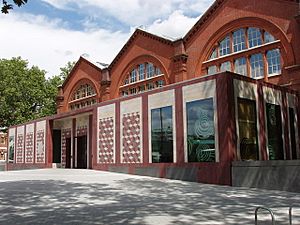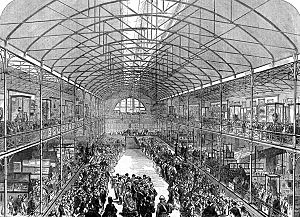- This page was last modified on 17 October 2025, at 10:18. Suggest an edit.
Young V&A facts for kids
 |
|
| Lua error in Module:Location_map at line 420: attempt to index field 'wikibase' (a nil value). | |
| Established | 1872 |
|---|---|
| Location | Bethnal Green London, E2 United Kingdom |
| Visitors | 386,944 (2019) |
| Public transit access | |
|
Listed Building – Grade II*
|
|
| Designated | 27 September 1973 |
| Reference no. | 1357777 |
| Area | 1.5 acres (6,100 m2), 145 galleries |
Young V&A, which used to be called the V&A Museum of Childhood, is a special museum in London. It's part of the famous Victoria and Albert Museum (the "V&A"), the UK's national museum for art and design. Located in Bethnal Green in the East End of London, Young V&A is all about things made for and by children. In 2024, it won the important Museum of the Year award.
The Museum's Early Days
| London Museum Site Act 1868 | |
|---|---|
| Act of Parliament | |

|
|
| Long title | An Act to provide for the Acquisition of a Site for a Museum in the East of London. |
| Citation | 31 & 32 Vict. c. 8 |
| Dates | |
| Royal assent | 28 February 1868 |
The museum first opened in 1872 as the Bethnal Green Museum. The building itself has a cool story. It was first built in South Kensington in the 1850s. It was made of iron sections that could be taken apart and put back together, like a giant kit.
When the building was moved to Bethnal Green, it was given a new red-brick exterior. Because of its iron structure, some people gave it the nickname "the Brompton Boilers." To make it look more beautiful, the outside walls were decorated with mosaic pictures showing farming, art, and science.
Over the years, the museum showed many different things. In the 1800s, it had displays about food and animals. It also showed famous artworks, including some that are now in the Wallace Collection. After World War I, it became more of an art museum and started a special section just for children, which grew bigger and bigger over time.
For a long time, the museum also displayed amazing sculptures by the artist Auguste Rodin. Another famous statue, The Eagle Slayer, was shown here from 1927 to 2017. It shows a man shooting an arrow at an eagle. This statue was originally made for the Great Exhibition of 1851.
Because of its special history and design, the museum building is protected as a Grade II* listed building. This means it is considered a very important building in England.
The Museum Today
Young V&A has the biggest collection of toys and other childhood items in the United Kingdom. In 1974, the director of the V&A, Sir Roy Strong, decided the museum should focus completely on childhood.
The museum's goal today is "To enable everyone, especially the young, to explore and enjoy the designed world, in particular objects made for and made by children." Inside, you can see huge collections of toys, games, children's clothes, and furniture from many different eras.
The museum closed in 2003 for a big makeover. It got a new roof, a new entrance, and all the displays were updated. It reopened in December 2006, looking better than ever.
Another big change began in 2019. More than 30,000 objects were carefully packed up to be moved to a new storage facility. The museum reopened with a fresh new look and name, Young V&A, on July 1, 2023. It now has new galleries designed to inspire creativity, imagination, and design skills in young people.
How to Get There
Here are some ways to travel to the Young V&A museum using public transport.
| Service | Station/stop | Stop letter | Lines/routes served | Distance from Young V&A |
|---|---|---|---|---|
| London Buses |
Bethnal Green Station |
Stop A | 106, 254, 309, 388, D3, D6 | |
| Stop B | 8, 309, D6 | |||
| Stop D | 8, 388, D3 | |||
| Old Ford Road |
Stop G | 106, 254, 388, D6 | ||
| London Underground |
Bethnal Green | |||
| London Overground |
Cambridge Heath | London Overground | 400 metres |
See also
- Anthony Burton (former director)

